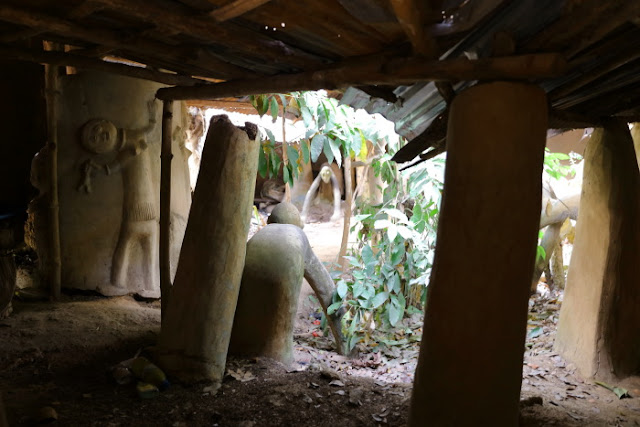 |
| Dancing away at Iya Osun's birthday |
The celebration took place in the lower courtyard of the
palace, next to the red walls of a shrine decorated with white, black and
orange designs.
 |
| the colourful shrine at the palace of the Oba of Osogbo |
As usual, marquees had been erected, in a corner, for people to seat and
have food and drinks while the celebration was going on. Indeed, celebrations
are a time to get together, a manifestation of the social link between
attendees, which can take several forms. The men would drink among their peers,
women would dance in groups, men would occasionally dance too, kids would play
around and occasionally partake in grown-ups’ activity, they would also look after
their siblings, etc…
The party had probably been called for 2pm and at 5pm it was
just about to start. Iya Osun’s group of women were about to start dancing and
singing in one of the rooms of the shrine. As usual here, some women would
carry their baby on their back wrapped in a cloth matching their outfit. The
babies would then sleep undeterred while the mother would be having fun and
dance the afternoon away. One of the prerequisite to enter the shrine is to go
barefoot. Shoes are left at the entrance. Anyway, flip-flops are never difficult to
get rid-off.
Two men were kneeling in front of a priest, dressed in the
cloth of the day, who wore a red and white bead necklace to mark his fellowship with
Esu (a divinity, or Orisha, which was associated with the devil by Christian missionaries, and which is said to manage the entrance doors of birth and death and also and be linked with uncertainty. He is also known to the father of the Ogbonis, the herbalists). The priest wore as well a
bead bracelet to the colors of Ifa (divination). He sat on a chair next to the
shrine while the two men were looking at something on the ground. Not sure what.
 |
| the Buseyin shrine dedicated to Osun |
We had met another priestess of Osun at the Buseyin shrine,
whose particularity is that it is nested on the banks of the Osun river but outside of
the sacred grove. The shrine is a rectangular enclosure whose mud wall is
adorned with concrete haut-reliefs representing mythological figures. The wall covered by a corrugated iron roof jutting out on both sides of it and
supported by pillars of mud thus forming an inner and outer gallery. Additionally, two entrances are magnified by A-shaped roof structures pointing
towards the sky like an Asian hat and supported by carved wooden poles made by
either Rabiu or Casali, two wood carvers that are part of the New Sacred Art
movement.
Inside the shrine some plants are growing along some mud and
concrete carvings, representing human-shaped divinities, which is giving a
lively air to the courtyard.
 |
| inside the Buseyin courtyard |
Comments
Post a Comment